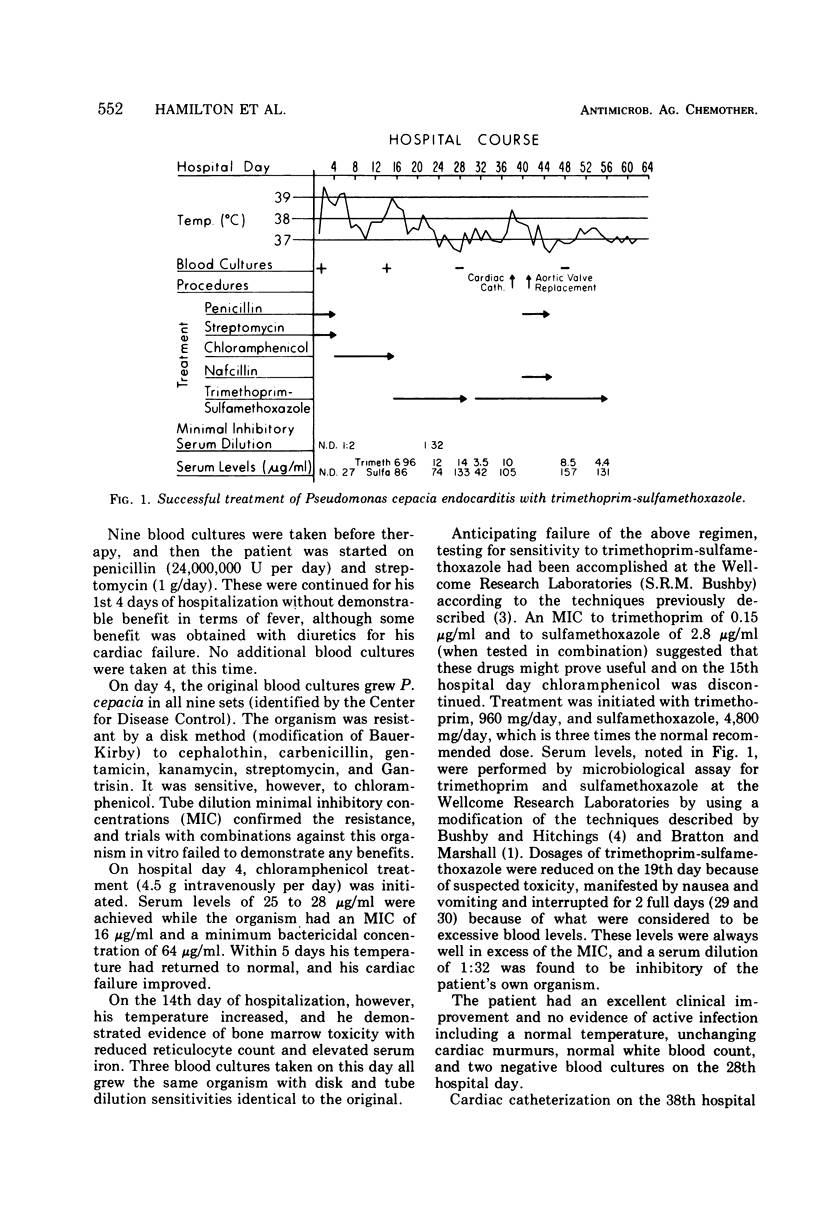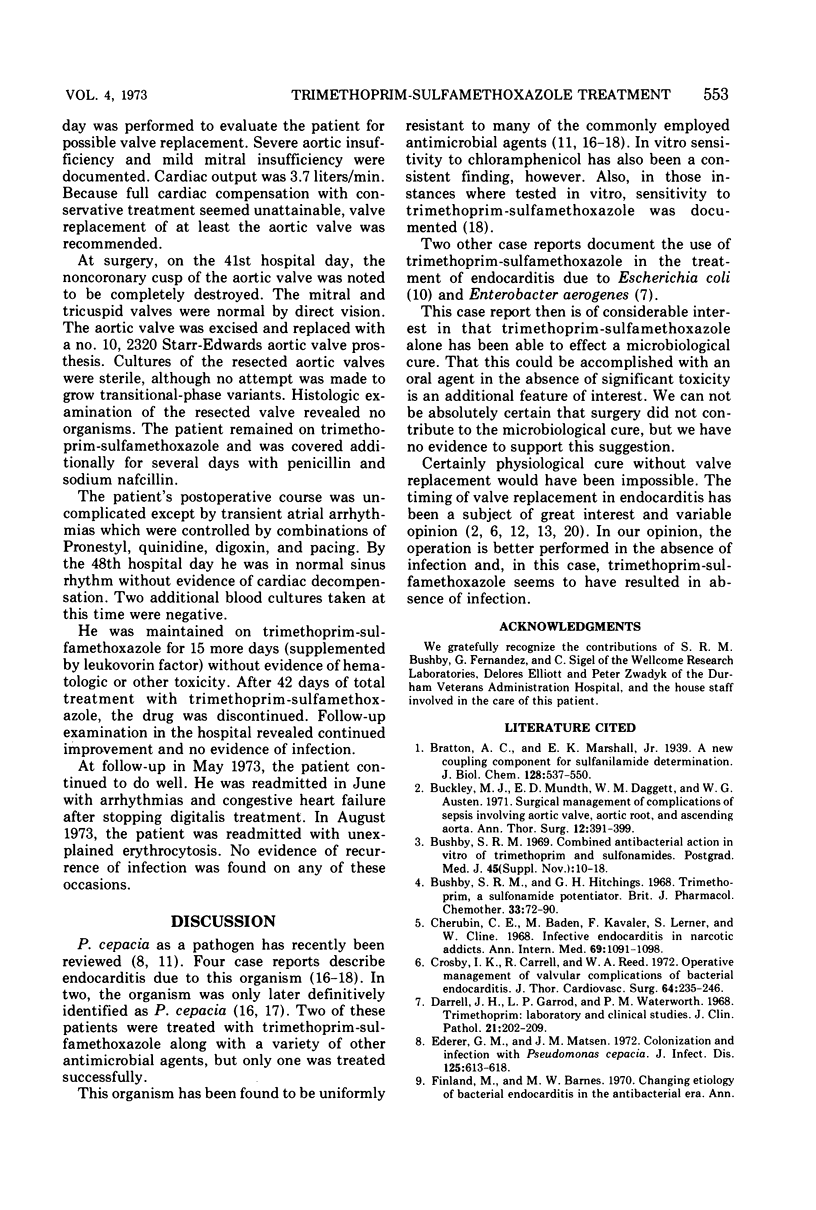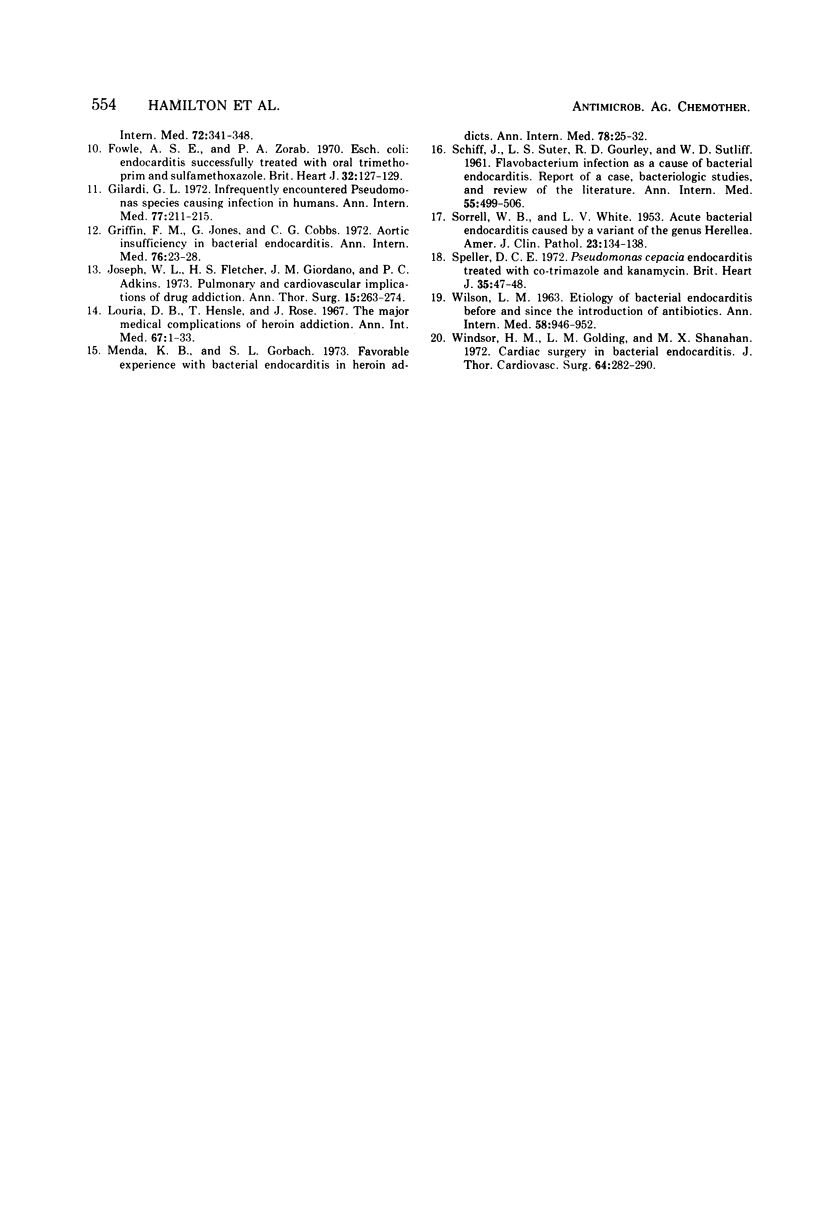Abstract
A patient with a history of alcoholism and drug abuse who developed Pseudomonas cepacia endocarditis is described. The organism was found to be resistant in vitro to all common antimicrobial agents except chloramphenicol and trimethoprim-sulfamethoxazole. Treatment failed with penicillin and streptomycin and later with chloramphenicol. Orally administered trimethoprim-sulfamethoxazole, however, resulted in sterilization of the patient's blood and aortic valve which was resected 27 days after the start of therapy. A 6-week course of therapy was completed and, to date (6 months after treatment), there has been no recurrence.
Full text
PDF



Selected References
These references are in PubMed. This may not be the complete list of references from this article.
- Buckley M. J., Mundth E. D., Daggett W. M., Austen W. G. Surgical management of the complications of sepsis involving the aortic valve, aortic root, and ascending aorta. Ann Thorac Surg. 1971 Oct;12(4):391–399. doi: 10.1016/s0003-4975(10)65141-7. [DOI] [PubMed] [Google Scholar]
- Bushby S. R. Combined antibacterial action in vitro of trimethoprim and sulphonamides. The in vitro nature of synergy. Postgrad Med J. 1969 Nov;45(Suppl):10–18. [PubMed] [Google Scholar]
- Bushby S. R., Hitchings G. H. Trimethoprim, a sulphonamide potentiator. Br J Pharmacol Chemother. 1968 May;33(1):72–90. doi: 10.1111/j.1476-5381.1968.tb00475.x. [DOI] [PMC free article] [PubMed] [Google Scholar]
- Cherubin C. E., Baden M., Kavaler F., Lerner S., Cline W. Infective endocarditis in narcotic addicts. Ann Intern Med. 1968 Dec;69(6):1091–1098. doi: 10.7326/0003-4819-69-6-1091. [DOI] [PubMed] [Google Scholar]
- Crosby I. K., Carrell R., Reed W. A. Operative management of valvular complications of bacterial endocarditis. J Thorac Cardiovasc Surg. 1972 Aug;64(2):235–246. [PubMed] [Google Scholar]
- Darrell J. H., Garrod L. P., Waterworth P. M. Trimethoprim: laboratory and clinical studies. J Clin Pathol. 1968 Mar;21(2):202–209. doi: 10.1136/jcp.21.2.202. [DOI] [PMC free article] [PubMed] [Google Scholar]
- Ederer G. M., Matsen J. M. Colonization and infection with Pseudomonas cepacia. J Infect Dis. 1972 Jun;125(6):613–618. doi: 10.1093/infdis/125.6.613. [DOI] [PubMed] [Google Scholar]
- Fowle A. S., Zorab P. A. Esch. coli endocarditis successfully treated with oral trimethoprim and sulphamethoxazole. Br Heart J. 1970 Jan;32(1):127–129. doi: 10.1136/hrt.32.1.127. [DOI] [PMC free article] [PubMed] [Google Scholar]
- Gilardi G. L. Infrequently encountered Pseudomonas species causing infection in humans. Ann Intern Med. 1972 Aug;77(2):211–215. doi: 10.7326/0003-4819-77-2-211. [DOI] [PubMed] [Google Scholar]
- Griffin F. M., Jr, Jones G., Cobbs C. C. Aortic insufficiency in bacterial endocarditis. Ann Intern Med. 1972 Jan;76(1):23–28. doi: 10.7326/0003-4819-76-1-23. [DOI] [PubMed] [Google Scholar]
- Joseph W. L., Fletcher H. S., Giordano J. M., Adkins P. C. Pulmonary and cardiovascular implications of drug addiction. Ann Thorac Surg. 1973 Mar;15(3):263–274. doi: 10.1016/s0003-4975(10)65295-2. [DOI] [PubMed] [Google Scholar]
- Louria D. B., Hensle T., Rose J. The major medical complications of heroin addiction. Ann Intern Med. 1967 Jul;67(1):1–22. doi: 10.7326/0003-4819-67-1-1. [DOI] [PubMed] [Google Scholar]
- Menda K. B., Gorbach S. L. Favorable experience with bacterial endocarditis in heroin addicts. Ann Intern Med. 1973 Jan;78(1):25–32. doi: 10.7326/0003-4819-78-1-25. [DOI] [PubMed] [Google Scholar]
- SCHIFF J., SUTER L. S., GOURLEY R. D., SUTLIFF W. D. Flavobacterium infection as a cause of bacterial endocarditis. Report of a case, bacteriologic studies, and review of the literature. Ann Intern Med. 1961 Sep;55:499–506. doi: 10.7326/0003-4819-55-3-499. [DOI] [PubMed] [Google Scholar]
- SORRELL W. B., WHITE L. V. Acute bacterial endocarditis caused by a variant of the genus Herrellea. Am J Clin Pathol. 1952 Feb;23(2):134–138. doi: 10.1093/ajcp/23.2.134. [DOI] [PubMed] [Google Scholar]
- Speller D. C. Pseudomonas cepacia endocarditis treated with co-trimoxazole and kanamycin. Br Heart J. 1973 Jan;35(1):47–48. doi: 10.1136/hrt.35.1.47. [DOI] [PMC free article] [PubMed] [Google Scholar]
- WILSON L. M. Etiology of bacterial endocarditis. Before and since the introduction of antibiotics. Ann Intern Med. 1963 Jun;58:946–952. doi: 10.7326/0003-4819-58-6-946. [DOI] [PubMed] [Google Scholar]
- Windsor H. M., Golding L. A., Shanahan M. X. Cardiac surgery in bacterial endocarditis. J Thorac Cardiovasc Surg. 1972 Aug;64(2):282–290. [PubMed] [Google Scholar]


